Helena Forti
Helena Forti (April 25, 1884 – May 11, 1942) was a dramatic soprano active 1906 – 1924, closely associated with the Dresden royal court opera, known for her beauty, voice and strong stage presence.[1] She sang all Wagner's opera heroines,[2] in Dresden, Bayreuth and internationally. Other repertoire included the title role in Verdi's Aida, Santuzza in Mascagni's Cavalleria and contemporary works such as Marietta in Korngold's Die tote Stadt. She created the role of Myrtocle in d'Albert's Die toten Augen.[3] Her Sieglinde in Die Walküre in Braunschweig was described by the Neue Zeitschrift für Musik[4] as "Equally endowed with youth, beauty and vocal means... (Forti) immerses herself so intensely in her role that one believes the transformation of the virgin-Goddess into a human form." After retiring from the stage she taught voice and acting in Gera, Düsseldorf and Vienna.[3] She died in Vienna, where she lived with her stage director and Intendant husband, Walter Bruno Iltz.
Helena Forti | |
|---|---|
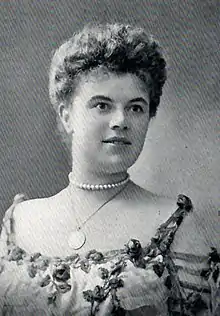 Portrait of Helena Forti, 1911 | |
| Born | Helene Minna Antonie Therese Fiedler 25 April 1884 Berlin, German Empire |
| Died | 11 May 1943 (aged 59) Vienna, Austria |
| Education | |
| Occupations |
|
| Organizations |
|
| Spouse | Walter Bruno Iltz (m. 1918) |
| Awards |
|
Family
Helene Minna Antonie Therese Fiedler in Berlin, on April 25, 1884.[5][6] An alternative birth date is 25 April 1886.[7][8] Forti was "a true stage child"[9] to theater-parents. Her father Anton Johann Fiedler, born August 29, 1838, "so called Forti",[10] was an operatic tenor[11][12] in Düsseldorf who retired from singing and by the 1880s was an "academic painter" who ran a shop renting out paintings and etchings[lower-alpha 1][13] Anton Forti died February 14, 1920.[14][15] [lower-alpha 2] "Forti" appears to have been the family's stage name, and her last name in the personnel file at the Dresden court theater was like her father's, "Fiedler, so-called Forti".[16]
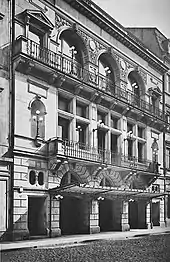
Her mother was the Dresden-Residenztheater actress[17] and operetta singer,[18] Minna Amalie Forti-Hänsel (before 1853 – c. 1925). Minna Hänsel was "one of the best soubrettes ever", according to the Die deutsche Schaubühne,[19] and played in the "second theater" in Dresden in 1869. After the loss of Gottfried Semper's "first court opera" due to fire, her theater closed as well, (it was deemed a fire hazard: the loss of Semper's court-theater prompted reevaluation in all theaters). Minna Hänsel moved to Berlin.[20] Semper would go on to rebuild the theater to its current form, where Minna Hänsel's daughter would sing for many years. Hänsel sang the title role in Offenbach's Helena at the Imperial German Court Theater (Kaiserlich-Deutsches Hoftheater) in St. Petersburg, in 1874,[21] becoming a well-known soubrette who sang in Chemnitz, Görlitz, Hannover, Stuttgart (summer theater in Berg), Stettin and in Dresden,[22] later a fine comic character-actress.[23] By 1872 the Residenz theater in Dresden was built in the Zirkusstrasse,[24] and Hänsel became one of its main artists.

The family's apartment in Dresden was in Zeughausstrasse 2, adjacent to the Synagogue (also designed by Gottfried Semper, the court opera architect). The Jewish local community had its offices in this building as well.[25] Apart from participation in a 1916 concert in the synagogue,[26] it is not known if Forti had any specific connection to the Jewish community or if she was Jewish – later, in 1933, her husband would be accused by the Nazi party of having a Jewish wife.[27]
Life
Already at age five, Helena appeared in children's roles at the Residenztheater in Dresden. Her professional stage debut was as an actress, at the Dessau court theater, at age sixteen in Goethe's The Brother and Sister (Die Geschwister).[28][29] In Dessau she played the "Naive and Sentimental" "Fach".[30] She also worked at the theater in Colberg.[31]
.jpg.webp)

In 1903 she studied singing with the Dresden baritone Karl Scheidemantel,[32] who would become opera director in Dresden in 1920, in her final years there; Further studies were with Teresa Emmerich in Berlin.[33] Forti's stage Debut as a soprano operatic singer came in 1906, as Valentine in Giacomo Meyerbeer's Les Huguenots at the Hoftheater Dessau,[34] where she was a member of the soloist ensemble, staying till 1907.[35] Numerous national and international performances followed, at the Royal opera in Stuttgart in 1907,[36] 1908–09 at the Brno Theater,[37] and 1910–11 in Angelo Neumann's Deutsches Theater in Prague. There she learned her first dramatic roles, and sang contemporary pieces such as Deltnar's Carmelita,[38] and Felix Weingartner's "Orestea Trilogie".[39] She sang as a guest in the Court Opera in Berlin (Valentine in Meyerbeer's Huguenots) in 1908,[40] in the theaters of Bremen and Braunschweig,[41] in Vienna (as Elisabeth in Tannhäuser) in 1910 and 1913, and at the Munich Wagner-Festival (in 1911). Her last performance in Prague was Leonora in Fidelio, Alexander von Zemlinsky conducted.[42]
Dresden 1911–1925
The reigning Wagner prima-donnas of the court theater of Dresden were Therese Malten and her successor Marie Wittich.[43] Stars of Dresden and Bayreuth, they made way for a new, dramatically oriented singer like Annie Krull, Strauss's choice for Diemuth (in Feuersnot) and the title role of Elektra.[44] Yet Krull failed to achieve Wittich's star-status and left Dresden for Mannheim in 1911.[45] Forti had first appeared in Dresden during the Esperanto Congress in 1908,[46] and in September 1911 sang Sieglinde in Die Walküre as a guest at the Royal court opera. She was then hired as Krull's replacement in the soloist ensemble, and started her contract in Dresden on October 14, 1911.[47] The music director, Ernst von Schuch, writing to Strauss, described Forti as "A Brunnhilde presence, with a big voice". Yet this very "Brunnhilde look" was a problem for Strauss, who warned against casting Forti as Salome, her being too "giant".[48] Strauss, later writing to the Dresden conductor Hermann Ludwig Kutzschbach, suggester her as the Composer in Ariadne (she later sang the title role), and was happy to accept her as Herodias in Salome (1916).[49] Forti's first role in Dresden was Elisabeth in Tannhäuser on October 25, 1911,[50] With Elisabeth, Forti earned a "noticeable success which should be decisive for her being further cast in Wagner roles. She brings not only the vocal size, but also the necessary pathos of expression."[51] and she remained in Dresden till 1925, her last performance that of Adriano in Wagners Rienzi.
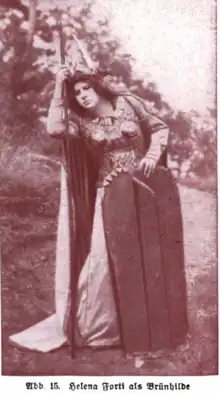
Forti sang the title roles of Aida, Fidelio[52] and Carmen,[53] Marina in Boris Godunov,[54] Santuzza in Cavalleria,[55] Antonia in Contes d'Hoffmann, Rachel in La Juive,[56] Leonore im Il Trovatore, Amelia in Ballo in Maschera and even Pamina in Die Zauberflöte, but mainly she was the Wagner-singer of Dresden: Senta in Der fliegende Holländer[57] Ortrud in Lohengrin,[58] Isolde in Tristan und Isolde,[59] Sieglinde in Die Walküre,[60] and all other Wagner heroines, Elsa, Eva, Brünnhilde, Fricka, etc. Forti sang more contemporary pieces as well, the title role of Ariadne auf Naxos, Minneleide in Pfitzner's Die Rose vom Liebesgarten; most notably she created the role of Myrtocle in d'Albert's opera Die toten Augen in 1916.[61]
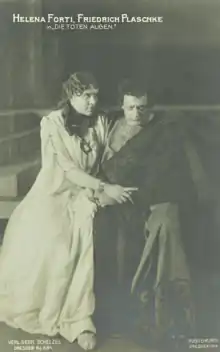

Forti's role is the most exposed, written in a late romantic idiom, high in tessitura and expansive in expression, containing music of tenderness such as Myrtocle's first monologue "Psyche wandelt durch Säulenhallen",[63] intensely dramatic sections such as "Doch! Doch! Doch!",[64] and the final duett with Arcesius (sung by Friedrich Plaschke) which closes the opera.[65] The opera proved a great success for the conductor Fritz Reiner and Forti, it was played often,[66] but did not enter into the canon of standard repertoire, the music and biblical theme of controversial quality.[67]
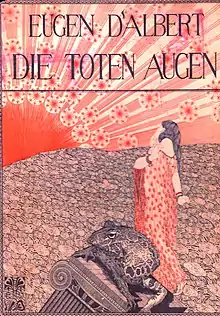
Other role creations were Maria in Arthur Wulffius's opera Gabina (1914),[68] Eroon in Karl v. Kaskel's Schmiedein von Kent,(1916)[69] Ilsebil in Naumann's opera Mantje timpe te, (1918), and Irene in Siegfried Wagner's Sonnenflammen, (1920). The opera was a success with the audience, due to Forti's excellent performance.[70][71] Forti also sang Dresden's first performances of Erich Wolfgang Korngold's Marietta in Die Tote Stadt and the title role in his Violanta,[72] as well as the role of Weibes (=a woman) in Paul Hindemith's opera, Mörder Hoffnung der Frauen[54][73]
During her Dresden period she sang in Amsterdam, Berlin (the world premiere of Alfred Kaise]'s Stella Maris),[74] Brussels, Bucharest, Cologne, Dessau (Isolde)[75] Munich,[76] Vienna, Zürich (Boris Godunov), and in Italy.[77] She appeared in the concerts of the summer season of 1920 in Toeplitz Schonau.[78]
In 1914 Forti appeared for her only season at the Bayreuth Festsical as Sieglinde in Die Walküre and Kundry in Parsifal.[79] Bühne und Welt[80] wrote: "It was an event. No stage should have two such powerful Kundry-interpreters at the same time. Forti drew from the depths of all femininity, and was – in her internalization, and lightly consuming ecstasy, of indescribable urgency. One experienced the mystery of compassion."
Forti received the title of Kammersängerin in 1917.[81] At the time of her death, Forti had two such titles, the one granted by the King in Dresden in 1917 ("Kgl. sächsische Kammersängerin"), it is unknown when and where she was granted the other title, "fürstlich-preußische Kammersängerin". .[lower-alpha 3]
Marriage to W.B. Iltz
in 1917, she married Dresden's "most famous and excellent"[82] actor Walter Bruno Iltz,[83] who was "always seen sitting in the artist's box when Forti sang, utterly immersed at her stage presence."[84] Iltz (1886–1965), was an actor in the Dresden Schauspiel, a stage-director and later general-director of the Reussisches Theater in Gera,(1924-19279), Düsseldorf Schauspiel (1927–1937), Volkstheater in Vienna (1938–1944), and after the war, the Nürnberg, Braunschweig and Düsseldorf theaters.[85] The wedding took place in Tegernsee, Bavaria,[86] where they purchased a house from Forti's tenor-colleague Leo Slezak.[87] In Dresden the couple lived in Forti's parent's apartment in Zeughausstraße 2. The Dresden artist Georg Gelbke designed the couple's wedding announcement, as well as stationary for her, based on a motif from Walküre.[88][89] The Forti-Iltz couple were an important part of the Dresden artistic society,[90] and were friends of Siegfried and Winifred Wagner, Paul Adolph (administrative director of the Dresden Theater), the Austrian-German literary scholar Oskar Walzel, [lower-alpha 4][1]Karl Mai,[91] the German author Max Mohr,[92][93] and others. The artist Rudolf Scheffler included them in his book of caricatures of the most famous members of the royal court theater in Dresden.[94]
Retirement from the stage
Forti's contract in Dresden Opera ended in 1925,[95] her performances in Dresden and elsewhere dwindled. Online and other references (e.g. Kutsch – Riemens Sängerlexikon)[96] to a "career breakthrough" in Germany after her "excellent"[97] Marina in Boris Godunov in 1923 cannot be sourced and are in error; Forti definitely retired from singing by 1925. Years of singing the dramatic repertoire and a possible addiction to morphium may have taken their toll.[98] Siegfried Wagner wrote her a flattering letter, expressing regret at her early retirement from the stage.[99]
Later life
Forti's mother Minna died about 1925. Forti and her husband left the apartment in Zeughausstrasse 2 (it was taken over by Kurt Striegler, the Dresden Kapellmeister). She followed her husband to Gera where he was Intendant and where she worked with the actors of his company.[100] According to Theo Anna Sprüngli, Forti now "saw her own success in the success of her husband, her highest ambition was to see him achieving his plans".[85] In Gera, Iltz's production of the 1925 play Katalaunische Schlacht by Arnolt Bronnen – a sexualized war drama [101] offended public sensibilities, and Iltz, as well as his wife received an anonymous letter with threat of being shot.[85] In 1929 Forti followed Iltz to Düsseldforf, where he was named general director, and where she also continued to coach actors,[1] and teach singing to (female) opera singers.[102][103]

The couple moved to Vienna, when Iltz became director of the Volksoper there. Forti died in Vienna, on the 11th of May, 1942, 58 years old, "after a long, severe nervous disorder triggered by her husband's clashes with the Nazi press and the Nazi party in Düsseldorf, which for many years had been "incomprehensible and agonizing" to her and her husband's existence".[85] She was buried in Tegernsee.[104]
Critical appreciation
There are no films or Video documents of Forti's artistry. She earned her place in the history of modern opera following the footsteps of singing actresses like Annie Krull.[105] Bühnen und Welt of 1909 describes the young Forti in the Prag Maifestspiele as a "youthful singer with great sensuous charm and excellent vocal, acting and intellectual qualities". Upon her farewell from Dresden, the Neue Zeitschrift für Musik summed her up as a „singing actress" who was "for more than ten years an 'artistic personality'", one who "unified acting and singing",[106] The author Oskar Walzel [lower-alpha 5] describes her Slavonic features, yet "on stage one could not imagine a more convincing personification of a Wagner heroine. Tall and slim, with reddish hair, she commanded gesture masterfully. Upon entering the stage as a Walkyrie, one says to one's self, this, and in no other way, should a Brünnhilde look like...[1] Yet Walzel and others[107] also comments that Forti's vocal material and craftsmanship did not match her visual qualities, Forti was "no replacement for Marie Wittich". ibid, [108] As early as 1911, Die Musik, while praising[109] her Senta in Der fliegende Holländer, notes a certain difficulty in the top range of her voice. Her first attempt at the role of Kundry was "scenically quite impressive" but vocally insufficient;[110] Her Isolde "looked better than it was sung",[111] By the end, Der Merker, merely labels her last performance (Adriano in Rienzi) as "disappointing".[112]
Theo A Sprüngli, the critic and activist wrote:
"An almost mystical magic, the magic of glowing life, emanated from her when she was on stage. She was always on fire inside, she always had to burn herself out; the fire of her enthusiasm, kindled by the primal-power of her heart, was never extinguished. Forti's innermost being was a rushing melody, her art a return of the heart to its divine origin: divine love."[85]

Recordings
Repertoire
Sources:
- Hochmuth: Chronicles of the Dresden opera (in German)[29]
- German Bühnenjahrbuch, (yearbook of theater activity) from 1943 (with an article about Forti listing her roles).[30]
- Dresden SLUB library, Musiconn, Repertoire list for Helena Forti[115]
- Other sources noted specifically
Composer – Role – Opera title – note (if any)
- d'Albert, Marion Liebesketten
- d'Albert, Marta, Tiefland
- d'Albert, Myrtocle‚Die toten Augen, Role creation, Dresden
- Aubert, Muette, Muette de Portici
- Beethoven, Leonore, Fidelio
- Bizet, Michaela, Carmen
- Deltnar, Carmelita, Carmelita, Role creation, Prague,[116]
- Goetz, Katharina Wiederspenstigen Zähmung
- Halevy, Rachel, La Juive[117]
- Hindemith, Frau, Mörder Hoffnung der Frauen
- Kaiser, Marga, Stella Maris[118]
- Kaskel, Eroon, Schmiedin von Kent, Role creation, Dresden
- Korngold, Marietta‚ die tote Stadt
- Leoncavallo, Nedda, Pagliacci[119]
- Mascagni, Santuzza, Cavalleria
- Meyerbeer, Valentine, Die Hugenotten
- Meyerbeer, Selika, Die Afrikanerin
- Mozart, Pamina, Die Zauberflöte
- Mussorgsky, Marina, Boris Godunow
- Naumann, Ilsebill‚ Mantje Timpe Te, Role creation, Dresden
- Offenbach, Antonia, Tales of Hoffmann
- Pfitzner, Minneleide, Die Rose vom Liebesgarten
- Strauss, Ariadne, Ariadne auf Naxos
- Verdi, Aida‚ Aida
- Verdi, Amelia, Un Ballo in Maschera
- Verdi, Leonora, Il Trovatore
- Wagner, Siegfrid, Irene, Sonnenflammen, Role creation, Dresden
- Wagner, Elisabeth, Tannhäuser
- Wagner, Elsa, Lohengrin
- Wagner, Senta, Der Fliegende Holländer
- Wagner, Brünnhilde, Die Walküre[120]
- Wagner, Brünnhilde, Götterdämmerung
- Wagner, Kundry, Parsifal
- Wagner, Adriano Rienzi
- Wagner, Sieglinde, Die Walküre
- Wagner, Isolde, Tristan und Isolde
- Wagner, Venus, Tannhäuser
- Wagner, Eva, Meistersinger
- Wagner, Fricke, Das Rheingold
- Wagner, Ortrud, Lohengrin
- Waltershausen, Rosine, Oberst Chabert[119]
- Weingertner, Kassandra, Orestes Trilogie, Role creation, Prague[39]
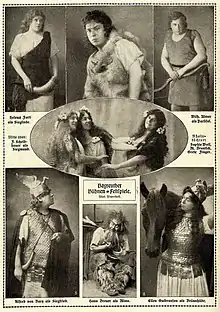
Literature (selected)
English:
- Calico, Joy, Staging Scandal with Salome and Elektra[121]
German:
- Detken & Schonau, Rollenfach und Drama[122]
- Hanke Krauss, Gabrielle, Richard Strauss Ernst von Schuch, ein Briefwechsel[123]
- Hochmuth, Michael, Chronik der Dresdner Oper – Zahlen, Namen, Ereignisse [71]
- Kugel, Wilfried, Der Unverantwortliche : das Leben des Hanns Heiz Ewers[61]
- Manker, Paulus, Enttarnung eines Helden: Das unbekannte Leben des Walter Bruno Iltz[85]
- Mühsam, Paul, Ich bin ein Mensch gewesen,Lebenserinnerungen[124]
- Stahl, Ernst Leopold, Das Mannheimer Nationaltheater, ein Jahrhundert deutscher Theaterkultur im Reich[125]
- Schäffler, Rudolf, HUKA ALBUM[94]
- Walzel, Oskar, Wachstum und Wandel[1]
German Periodicals from the beginning of the 20th Century:
- Berliner Illustrirter Zeitung
- Bühne und Welt
- Die Musik
- Die Stimme: Centralblatt für Stimm- und Tonbildung, Gesangunterricht und Stimmhygiene
- Menschen, Monatsschrift für neue Kunst. volumes 3–5 1920–22
- Neue Zeitschrift für Musik
- Neue Musik Zeitung
- Signale für die musikalische Welt
Notes
- today he would be regarded as decorator perhaps; he owned a store renting out paintings and etchings for different occasions
- This is not the Viennese Mozart and Weber Baritone Anton Forti (1790–1859)
- either from the Dessau or Gera theaters
- Walzel: (Walzel, Oskar F. (Oskar Franz), 1864–1944)
- Oskar Franz Walzel, 1864–1944, Austrian-German writer and literary scholar, a professor in Dresden (during Forti's years there)
References
- Walzel, Oskar (1956). Wachstum und Wandel [Growth and change] (in German). Berlin: Erich Schmidt Verlag.
- Neue Zeitschrift für Musik, 1924 Jg91, p. 658
- Neue Zeitschrift für Musik 1924 Jg91, s. 658
- 1915 Jg. 82
- Landesarchiv Berlin; Berlin, Deutschland; Personenstandsregister Geburtsregister; Laufendenummer: 188
- Hochmuth, Michael (1988). Chronik der Dresdner Oper – Zahlen, Namen, Ereignisse [Chronicles of the Dresden Opera, Numbers, Names and Events] (in German). Hamburg: Verlag Dr. Kovač. ISBN 978-3-86064-826-1.
- This is doubtful, since the 1884 date is confirmed by a birth certificate
- Bühnenjahrbuch 1943
- Neue Zeitschrift für Musik, 1924 Jg91 p.658
- Adreßbuch für Dresden und Vororte Bandzählung1887|according to the Dresden Address book of 1887
- Landesarchiv Sachsen-Anhalt; Magdeburg, Deutschland; Film Number: 1190634, his first marriage to a Laura Fricke lists him as an operatic tenor in Düsseldorf.
- Deutsches bühnen-jahrbuch ; theatergeschichtliches jahr- und adressenbuch .v.22 1911, p.233|Minna Hänsel, married to the former tenor and currently painter Anton Forti.
- Dresden, SLUB. "Adreßbuch für Dresden und Vororte". digital.slub-dresden.de.
- Stadtarchiv der Landeshauptstadt Dresden; Dresden, Deutschland; Städtisches Friedhofs-und Bestattungswesen-Krematorium Tolkewitz und Urnenhain; Einäscherungsbücher Dresden 1911–1952; Repositurnummer: 9.1.24; Laufende Nummer der Registerbandes: 1920
- Adreßbuch für Dresden und Vororte Bandzählung1920
- Ministerium des Königlichen Hauses Archivaliensignatur, Loc. 44 Nr. 49, years 1915 – 1917
- cast list from Residenztheater
- Detken and Schonlau (2014). Rollenfach und Drama [Role type and drama] (in German). Gunter Narr Verlag. ISBN 978-3823368427. page 183
- Die deutsche Schaubühne, Organ für theater und literatur. Jahrg.10 (1869)
- Not in the scope of this article, yet a demonstration of her mother's fame: The Pall mall budget, v.4 1870, reports of Minna Hänsel's creation of an "amazons corps" which was treated with derision. "That spirited lady had actually already gathered fifty-three young heroines under her banners, all ready and eager for the fray...Yet before proceeding further it was considered wise to inquire at head-quarters in what portion of the army these female volunteers would be considered most desirable. A letter was therefore addressed to General~Governor Von Falckenstein, whose answer, somewhat delayed, arrived a few days ago. He declines with many thanks the patriotic offer of their guarding the coast...Miss Hansel, however, "considering the rapid and victorious progress of the war," thinks that the delay in the general's answer has frustrated her plans, and has accordingly disbanded her corps." This was reported widely, including Kladderadatsch v.22–23 yr.1869–70, and in the Deutsche Schaubühne, 1869 and in Ellen C. Clayton, Female Warriors, Tisnley Brothers, 1879
- "Vabandust! — DIGAR Eesti artiklid". dea.digar.ee.
- Neue Zeitschrift für Musik1911 Jg. 78 p.635|Forti and her mother's career
- Dresdner neueste Nachrichten , 23.04.1903, p.2| positive review of Minna Hänsel's comic talent.
- The large building seated more than 1100 people, played operettas and lighter plays. By 1934 it was converted to a storage space, and was destroyed in 1945
- Dresden historic address books, 1900–1925)
- Neue Zeitschrift für Musik, 83. jg, 1916, p.55
- Manker, Paulus (2014). Enttarnung eines Helden: Das unbekannte Leben des Walter Bruno Iltz [Uncovering a hero: the unknown life of Walter Bruno Iltz] (in German). Berlin: Alexander Verlag. ISBN 978-3895813405.| p. 49
- Forti as actress in Dessau Deutsches bühnen-jahrbuch v.13 1902.Listing: 'Dessau'
- Hochmuth, Michael (1988). Chronik der Dresdner Oper – Zahlen, Namen, Ereignisse [Chronicles of the Dresden Opera, Numbers, Names and Events] (in German). Hamburg: Verlag Dr. Kovač. ISBN 978-3-86064-826-1.
- Deutsche Bühnen Jahrbuch, 1943
- Deutsches bühnen-jahrbuch v.14 1903.Listing: 'Colberg'
- Vrbka Tomáš, Státni opera Praha: opera 1888–2003 : historie divadla v obrazech a datech, 2004, 597 pages. p.111
- Musical courier,a weekly journal devoted to music and the music trades, 1908| Forti as student of Teresa Emmerich in Berlin (advertisement of Emmerich) p. 14
- Hall, Charles (1989). A twentieth-century musical chronicle : events 1900–1988. Greenwood. ISBN 0313265771. Debut 1906 in Dessau
- Deutsches bühnen-jahrbuch,v.18 1907|HF listed under 'Dessau'
- Chronik der kgl. Haupt- und Residenzstadt Stuttgart [Chronicles of the royal capital and residence town Stuttgart]. Stuttgart: Verlag Gemeinderat. 1907.
- Deutsches Bühnen Jahrbuch, v.19, 1908
- which was cancelled after the first performance. The papers were full of general director Neumann, the composer, and the "Temperamentvolle Diva (='Diva full of personality') Helena Forti".
- Bühne und Welt: 1909, v. 11, P.830
- Guide musical; Revue internationale de la musique et de theâtres lyriques, Vol. 60|Review of Valentine in Huegenottes (with Siems, Vogelstrom, Staegemann)
- Bühne und Welt, v. 2;v. 11, 1909
- Deutsche Arbeit, v. 11,Ausgaben 1–6, 1911| comments on Forti's positive development as a singer, and regrets her departure.
- Cowgill & Poriss, Calico, Joy, ed. (2012). The arts of the primadonna in the long ninetreenth century. Oxford: Oxford university press. p. 68. ISBN 978-0195365887.
{{cite book}}: CS1 maint: multiple names: editors list (link)Calico, Joy, Staging Scandal with Salome and Elektra, - Timpano, Nathan (2017). Constructing the Viennese Modern Body: Art, Hysteria, and the Puppet. Taylor and Francis limited. ISBN 978-1138220188.
- Stahl, Ernst Leopold (1929). Das Mannheimer Nationaltheater, ein Jahrhundert deutscher Theaterkultur im Reich [The national theater in Mannheim, a century of theater culture in the German empire] (in German). J. Bensheimer.p.287
- La Bela mondo. 1908–1909, Dresden. p.12-14 in Esperanto, no publisher given
- Hanke Krauss, Gabriella (1999). Richard Strauss Ernst von Schuch, ein Briefwechsel [Richard Strauss Ernst von Schuch, letters] (in German). Henschelverlag. letter of October 13, 1911
- Hanke Krauss, Gabriella (1999). Richard Strauss Ernst von Schuch, ein Briefwechsel [Richard Strauss Ernst von Schuch, letters] (in German). Henschelverlag. ISBN 978-3894873295.
- Richard Strauss und die Sächsische Staatskapelle: Tagungsband, Georg Olms, 2019, ISBN 978-3-487-15701-6, p.615
- Neue Zeitschrift für Musik, 1911 v. 78, p.635
- Die Musik, vl. 12, XLVI, 1912–1913 p.299
- Die Musik 11Jg, 1Q, v.41, 1911–1912, p.441
- Bühne und Welt, p. 137 vol 16 part 2, 1914
- Neue Zeitschrift für Musik, 1923 Jg90
- Die Musik 11Jg, 2Q, V.42, 1911–1912, p.425
- Neue Zeitschrift für Musik, 1917,p.84
- Die Musik, 11Jg, 1Q, Bd.41, 1911–1912 |Senta in Dresden p.354
- Die Musik, 14Jg, 1Q, Bd.53, 1914–1915 s.254 |Ortrud in Dresden
- Watt, Charles E., 1861–1933 Music news
- Neue Zeitschrift für Musik, 1911 Jg. 78p.635
- Kugel, Wilfried (1992). Der Unverantwortliche : das Leben des Hanns Heiz Ewers [The irresponsible: the life of Hanns Heiz Ewer] (in German). Grupello. ISBN 978-3928234047.
- Berliner illustrierte Zeitung. v.25(1916).p.151
- D'Albert Eugen, Die Toten Augen, Bote und Bock, 1913, p. 69
- D'Albert Eugen, Die Toten Augen, Bote und Bock, 1913, p. 76
- D'Albert Eugen, Die Toten Augen, Bote und Bock, 1913, p. 159-202
- Bie, Oskar, die Oper, S.Fischer, Berlin, 1938, p.549
- Neue Zeitschrift für Musik 1916 Jg083, p.91
- Bühne und Welt v.16,pt.2 (1914), p.279
- Neue Musik Zeitung, 37 Jg 1916 pp. 61, 153.
- Menschen. "Monatsschrift für neue Kunst." volumes 3–5 1920–22. p.55.
- Hochmuth, Michael (1988). Chronik der Dresdner Oper – Zahlen, Namen, Ereignisse [Chronicles of the Dresden Opera, Numbers, Names and Events] (in German). Hamburg: Verlag Dr. Kovač. ISBN 978-3-86064-826-1.
- Neue Zeitschrift für Musik, 1916 Jg. 83
- Neue Musik Zeitung 43 Jg 1922
- Die Musik, 12Jg, 2Q, Bd.46, 1912–1913 feb 1913
- Neue Zeitschrift für Musik, 88. Jg 1921, p.368
- Signale für die musikalische Welt v.69 1911 no.3-5,18,20–21,23–38,40–48.|Münchener Festspiele
- Die Stimme: Centralblatt für Stimm- und Tonbildung, Gesangunterricht und Stimmhygiene, Bände 13–14, p.247
- Neue Zeitschrift für Musik 1920 Jg87 p.474
- Die Musik 14Jg, 1Q, Bd.53, 1914–1915, s. 333
- Bühne und Welt, vol 16 part 2, 1914 p.137
- Neue Musik Zeitung, 38 Jg 1917, p.295
- Mühsam, Paul, Ich bin ein Mensch gewesen,Lebenserinnerungen, Bleicher Verlag, Gerlingen, 1989, s. 175
- Neue Musik Zeitung 38 Jg 1917, p. 375
- Walzel, Oskar (1956). Wachstum und Wandel [Growth and change] (in German). Berlin: Erich Schmidt Verlag. pp.128–129
- Manker, Paulus (2014). Enttarnung eines Helden: Das unbekannte Leben des Walter Bruno Iltz [Uncovering a hero: the unknown life of Walter Bruno Iltz] (in German). Berlin: Alexander Verlag. ISBN 978-3895813405.
- Deutsches Bühnen-Jahrbuch Spielzeit 1966/67. Genossenschaft Deutscher Bühnen-Angehörigen, Deutscher Bühnenverein, F. A. Günther & Sohn, Hamburg 1967
- Adolph, Paul (1932). Vom Hof zum Staatstheater [From court theater to State theater] (in German). Dresden: C.Heinrich Verlag. p.355
- http://www.exlibris-archiv.de/EXL-KUENSTLER/exl-kue-Gelb/Bieger.pdf
- Mitteilungen des Exlibrisvereins zu Berlin. jahrg.7–11 (1913–17). p. 13
- Die Woche V.20, 1918, Teil 1 ( Jan März), p. 170
- "Klara Mays: Die Lieblingsschriftsteller Karl Mays * Mit Anmerkungen von Hans Wollschläger" [Clara May: Karl Mays' favorite writer * With comments by Hans Wollschläger]. www.karl-may-gesellschaft.de (in German).
- Max Ludwig Mohr (1891–1937), Jewish author, lived in Tegernsee, emigrated to Shanghai 1934: Gabriele Geibig-Wagner: Max Mohr – ein wiederentdeckter Schriftsteller. In: Ulrich Wagner (Hrsg.): Geschichte der Stadt Würzburg. 4 Bände, Band I-III/2, Theiss, Stuttgart 2001–2007; III/1–2: Vom Übergang an Bayern bis zum 21. Jahrhundert. 2007, ISBN 978-3-8062-1478-9
- Steger, Florian (2020). Max Mohr: Arzt und rastloser Literat (in German). Friedrich Pustet Verlag. ISBN 978-3791730752.
- Scheffler, Rudolf (1918). HUKA ALBUM, Humoristischer Künstlerabend von Mitgliedern der Königl. Hoftheater Dresden [HUKA album, a humorous artist's evening of members of the royal court theater in Dresden] (in German). Dresden: Alfred Waldheim und Co.
- Hochmuth, Michael (1988). Chronik der Dresdner Oper – Zahlen, Namen, Ereignisse [Chronicles of the Dresden Opera, Numbers, Names and Events] (in German). Hamburg: Verlag Dr. Kovač. ISBN 978-3-86064-826-1.
- Kutsch, Karl-Josef; Riemens, Leo (22 February 2012). Großes Sängerlexikon. ISBN 9783598440885.
- Musical Courier: A Weekly Journal Devoted to Music and the Music Trades, Band 87, 1923, p.23
- W.B. Iltz's colleague the choreographer Yvonne Georgi, quoted inManker, Paulus (2014). Enttarnung eines Helden: Das unbekannte Leben des Walter Bruno Iltz [Uncovering a hero: the unknown life of Walter Bruno Iltz] (in German). Berlin: Alexander Verlag. ISBN 978-3895813405.|p. 88
- Ibid
- Neue Musik Zeitung, 45 Jg 1924, p.23
- Manker, Paulus (2014). Enttarnung eines Helden: Das unbekannte Leben des Walter Bruno Iltz [Uncovering a hero: the unknown life of Walter Bruno Iltz] (in German). Berlin: Alexander Verlag. ISBN 978-3895813405.| p. 88
- Neue Zeitschrift für Musik, 1924, Jg91, p.729|Well-known teacher of female voices
- Harold Rosenthal, OPERA ANNUAL 1954–1955, 1954, JOHN CALDER LTD
- Hochmuth, Michael (1988). Chronik der Dresdner Oper -Zahlen, Namen, Ereignisse [Chronicles of the Dresden Opera, Numbers, Names and Events] (in German). Hamburg: Verlag Dr. Kovač. ISBN 978-3-86064-826-1.
- Cowgill & Poriss, Calico, Joy, ed. (2012). The arts of the primadonna in the long ninetreenth century. Oxford: Oxford university press. p. 68. ISBN 978-0195365887.
{{cite book}}: CS1 maint: multiple names: editors list (link)Calico, Joy, Staging Scandal with Salome and Elektra - Neue Zeitschrift für Musik 1924 Jg91, p.658
- Die Musik: Verzeichnis der Kunstbeilagen, Band 12,Ausgabe 3
- Die Musik: Verzeichnis der Kunstbeilagen, Band 12,Ausgabe 3
- Die Musik 11Jg, 1Q, Bd.41, 1911–1912 p.354
- Neue Zeitschrift für Musik 1914 Jg081, p.562
- Die Musik, 14jg 3q Bd. 551914 1915 ( 1) p.85
- Der Merker, Band 4;Band 10
- EMI Music archive His Master's Voice: The German Catalogue : a Complete Numerical Catalogue of German Gramophone Recordings Made from 1898 to 1929 in Germany, Austria, and Elsewhere by the Gramophone Company Ltd.
- "SLUB Mediathek". mediathek.slub-dresden.de.
- "musiconn.performance — Person". performance.slub-dresden.de. Archived from the original on 2021-06-14.
- Neue Musik Zeitung, 31 Jg, 1910, p.108
- Neue Zeitschrift für Musik 1917 Jg084, p.250
- Forti, Helena (July 24, 2003). "Helena Forti, Rollenbild, Hüftbild, in: Alfred Kaiser: Stella Maris". Gebr. Schelzel. – via Open WorldCat.
- "musiconn.performance — work". performance.slub-dresden.de. Archived from the original on 2021-02-26.
- Neue Zeitschrift für Musik 1915 Jg082, p. 348
- Cowgill & Poriss, Calico, Joy, ed. (2012). The arts of the primadonna in the long ninetreenth century. Oxford: Oxford university press. p. 68. ISBN 978-0195365887.
{{cite book}}: CS1 maint: multiple names: editors list (link) - Detken and Schonlau (2014). Rollenfach und Drama [Role type and drama] (in German). Gunter Narr Verlag. ISBN 978-3823368427.
- Hanke Krauss, Gabriella (1999). Richard Strauss Ernst von Schuch, ein Briefwechsel [Richard Strauss Ernst von Schuch, letters] (in German). Henschelverlag.
- Mühsam, Paul, Ich bin ein Mensch gewesen,Lebenserinnerungen, Bleicher Verlag, Gerlingen, 1989
- Stahl, Ernst Leopold (1929). Das Mannheimer Nationaltheater, ein Jahrhundert deutscher Theaterkultur im Reich [The national theater in Mannheim, a century of theater culture in the German empire] (in German). J. Bensheimer.